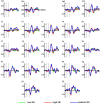Processing Self-Related Information Under Non-attentional Conditions Revealed by Visual MMN
- PMID: 35463934
- PMCID: PMC9019658
- DOI: 10.3389/fnhum.2022.782496
Processing Self-Related Information Under Non-attentional Conditions Revealed by Visual MMN
Abstract
Mismatch negativity (MMN) of event-related potentials (ERPs) is a biomarker reflecting the preattentional change detection under non-attentional conditions. This study was performed to explore whether high self-related information could elicit MMN in the visual channel, indicating the automatic processing of self-related information at the preattentional stage. Thirty-five participants were recruited and asked to list 25 city names including the birthplace. According to the difference of relevance reported from the participants, we divided names of the different cities into high (birthplace as deviants), medium (Xi'an, where participants' university is located, as deviants), and low (totally unrelated cities as standard stimuli) self-related information. Visual MMN (vMMN) was elicited by high self-related information but not by medium self-related information, with an occipital-temporal scalp distribution, indicating that, under non-attentional condition, high self-related information can be effectively processed automatically in the preattentional stage compared with low self-related information. These data provided new electrophysiological evidence for self-related information processing.
Keywords: ERPs; change detection; preattentional processing; self-related information; vMMN.
Copyright © 2022 Cheng, Li, Zhan, Wang, Guo, Huang, Cao, Feng, Wang, Wu, An, Wang, Zhao and Liu.
Conflict of interest statement
The authors declare that the research was conducted in the absence of any commercial or financial relationships that could be construed as a potential conflict of interest.
Figures




Similar articles
-
Differences in the neural basis of automatic auditory and visual time perception: ERP evidence from an across-modal delayed response oddball task.Brain Res. 2010 Apr 14;1325:100-11. doi: 10.1016/j.brainres.2010.02.040. Epub 2010 Feb 17. Brain Res. 2010. PMID: 20170647
-
The visual mismatch negativity elicited with visual speech stimuli.Front Hum Neurosci. 2013 Jul 16;7:371. doi: 10.3389/fnhum.2013.00371. eCollection 2013. Front Hum Neurosci. 2013. PMID: 23882205 Free PMC article.
-
The effect of visual task difficulty and attentional direction on the detection of acoustic change as indexed by the Mismatch Negativity.Brain Res. 2006 Mar 17;1078(1):112-30. doi: 10.1016/j.brainres.2005.12.125. Epub 2006 Feb 21. Brain Res. 2006. PMID: 16497283
-
The quest for the genuine visual mismatch negativity (vMMN): Event-related potential indications of deviance detection for low-level visual features.Psychophysiology. 2020 Jun;57(6):e13576. doi: 10.1111/psyp.13576. Epub 2020 Apr 15. Psychophysiology. 2020. PMID: 32293040
-
Mismatch negativity of ERP in cross-modal attention.Sci China C Life Sci. 1997 Dec;40(6):604-12. doi: 10.1007/BF02882690. Sci China C Life Sci. 1997. PMID: 18726284
References
-
- Alexopoulos T., Muller D., Ric F., Marendaz C. (2012). I, me, mine: automatic attentional capture by self-related stimuli. Eur. J. Soc. Psychol. 42 770–779. 10.1002/ejsp.1882 - DOI
-
- Alves N. T., Fukusima S. S., Aznar-Casanova J. A. (2008). Models of brain asymmetry in emotional processing. Psychol. Neurosci. 1 63–66. 10.3922/j.psns.2008.1.010 - DOI
LinkOut - more resources
Full Text Sources

